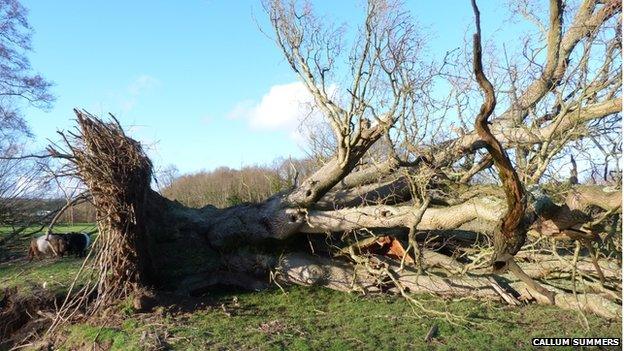Tree storm damage 'worst since 1987'
- Published

A 600-year-old oak tree lost at Woolbedding Estate
This winter's extreme winds caused the biggest loss of trees in more than 20 years, according to the National Trust.
Some of their sites have seen the greatest number of trees knocked down since the Great Storm of 1987.
A number of rare and historic specimens have been lost, including the largest tree in Essex.
Researchers from the Trust are worried that the winds will have severely weakened many older trees.
The National Trust is one of Britain's biggest landowners and look after 25,000 hectares of trees across England, Wales and Northern Ireland.
After the extreme weather of the past few months they've now carried out a survey at more than 50 of their sites.
While they don't know the full number of trees that have gone, they say it is the greatest loss of trees in two decades.
In some cases, greater damage has been done than during the Great Storm of 1987.
The saturated state of the earth following the prolonged downpours had greatly weakened the soil. As a result of the 10-15 storms over the winter, many trees gave way.
"It is definitely the greatest period of loss since January 1990," said Matthew Oates from the Trust.
"In 1987 and 1990 it was really the volume that was lost that was worrying, this time it is the quality of the trees. We've lost a lot of significant, old sentinel trees, ancient beech, oak and ash trees."
Near Polperro, in Cornwall, Mark Squire, from Custard Duck Photography, filmed a row of about 15 trees which had been uprooted near Sclerder Lane
The western and southern half of England and Wales have borne the brunt of the losses. Some historic and regionally important trees have gone, including a rare black walnut at Hatfield Forest, which was the largest in Essex.
The Killerton Estate in Devon had more than 500 trees blown over by the storms, including 20 significant trees within the design landscape.
Alan Power, head gardener at Stourhead in Wiltshire, said his garden had lost up to 400 trees with some important specimens now gone.
"We've lost one spectacular oak tree, which could well be between 200 and 250 years old and planted by the man who created the landscape garden at Stourhead," he said.
While the losses are a concern for the Trust there are some positives. The fallen trees encourage a range of species, increasing the biodiversity of forests.
"Dead wood as we call it, is a great habitat for beetles, flies and fungi and once a tree has fallen and is left there, then there's 25 years of really important ecology happening," said Matthew Oates.
Going forward, the Trust is concerned that many trees have "lifted" their roots, having been loosened by the storms and that these may have to be cut down if they are close to a pathway or road.
Follow Matt on Twitter, external.
- Published17 February 2014
- Published18 February 2014
- Published15 February 2014